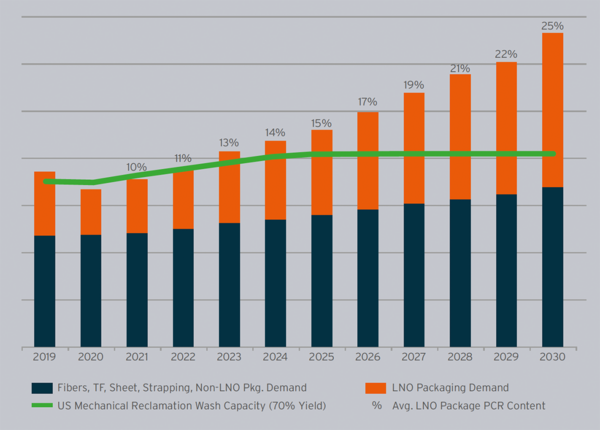The current post-consumer recycled (PCR) content rate is ~9% and most brands have 2025 goals with a 15% minimum PCR content. Aspirational recycled content levels go much higher than 15%. The unfortunate reality is that the current U.S. reclamation infrastructure cannot generate the needed volumes of rPET pellets by 2025. These rPET content commitments create a strong and immediate opportunity for investments in rPET reclamation.


PETnology Series: "Month in Charts" - a Service by SBAcci
Investing in rPET Infrastructure to Meet 2025 Goals
PET is the largest rigid packaging plastic by volume in the United States. It is also the most recycled plastic in the US. The US Environmental Protection Agency (EPA) provides 2019 recycle rate of ~28% for PET that follows aluminum packaging (all formats) at 35% and glass packaging at 31%. The strong commitment to increased recycled PET (rPET) content in packaging will increase demand and create supply shortages.

The U.S. rPET industry is currently in relative balance for supply and demand, but the system is under stress to rapidly grow rPET pellet supply. A June 2021 report by the American Chemistry Council, the Association of Plastic Recyclers, and the Foundation for Plastics Recycling shared the following U.S. sourced PET recycling details: The 2019 PET bottle recycling rate was 27.9%, with 1.78 B Lbs. of recaptured PET, the mechanical reclamation capacity was 2.4 B Lbs., and U.S resin demand for “PET Bottles” was 6.4 B Lbs. These rPET volumes are not yield adjusted, so at 70% yield the ~1.8 B. Lbs. of feedstock becomes ~1.3 B Lbs. and the ~2.4 B Lbs. of capacity becomes ~1.7 B Lbs. Much of the rPET recycle stream is currently consumed in non-packaging applications such as fibers, film/sheet, strapping, polyols, etc. The reality is that supply growth for LNO packaging needs to come from new operations and not from the re-directing current infrastructure.
Mechanical reclamation for rPET is essential to maintaining and growing the current PCR content levels. We should expect to see capacity expansions similar to recent announcements by PolyQuest, Indorama, and others. There will be no net growth in U.S. rPET volumes without the foundation of mechanical reclamation operations. These provide both finished LNO pellets and the preparation steps that enable depolymerization. These operations are vital to successfully reaching sustainability goals. Related, we also need increased supply of used PET bottles to feed them.
Depolymerization technologies (“advanced recycling” or “enhanced recycling”) are also being proposed to help grow rPET supply in the U.S. packaging market. Some types of advanced recycling technologies have been successfully practiced for decades. Other proposed platforms are based on novel innovations that are less proven and may not have been practiced beyond lab trials. It becomes a stretch to believe that some of these non-previously practiced technologies can reliably deliver large volumes of high quality of rPET pellets within a few years. Perhaps some of these technologies are better considered as longer-term options than additional 2025 supply.
The use of “Single Pellet Solution” must be considered to meld with U.S virgin PET operations to increased rPET supply. This process involves substituting a portion of the traditional vPET feedstocks (PTA and EG) with an advanced recycling product, which is typically BHET or DMT, or in situ glycolysis. The resulting vPET contains some level of rPET but with minimal variation from vPET produced from traditional feedstocks. North America vPET production capacity in 2021 is roughly 11 B Lbs. If 50% of the NA vPET operations could be converted to SPS that create a vPET with 20% PCR content, then a new rPET supply of ~1 B Lbs. would be enabled. The SPS process is known and has been successfully practiced, including its use at European vPET operations. This also assumes that NA rPET operations owned by vPET producers would continue to operate and supply to the market just as they do today. So the value of a SPS model is that the volume is all additive to current mechanical reclamation volumes and that the resin with rPET content is very similar to current vPET materials.
Promptly enabling SPS has inherent benefits but is not the only option for growing rPET supply. Advanced recycling can have a strong role in longer term rPET supply growth. There are common challenges to the overall recycling value chain that need be addressed. These include the requirement for increased capture of used PET bottles, improving MRF operation efficiencies, and the recognition of what level of PCR content is truly feasible by 2025. The U.S. recycling industry has a window to ramp up rPET supply. The much-increased demand for rPET is visible and real. It’s time to build an improved U.S. infrastructure that can address these needs. Mechanical reclamation in various formats will continue to baseload U.S. supply of rPET. It will be exciting to see new rPET operations built that support the 2025 demand goals. And as always, we need to increase bottle recycling rates to feed existing and new operations.

Author: Steve Lyons for SBAcci
lyons.consultinginc@gmail.com
The comPETence center provides your organisation with a dynamic, cost effective way to promote your products and services.

magazine
Find our premium articles, interviews, reports and more
in 3 issues in 2025.

